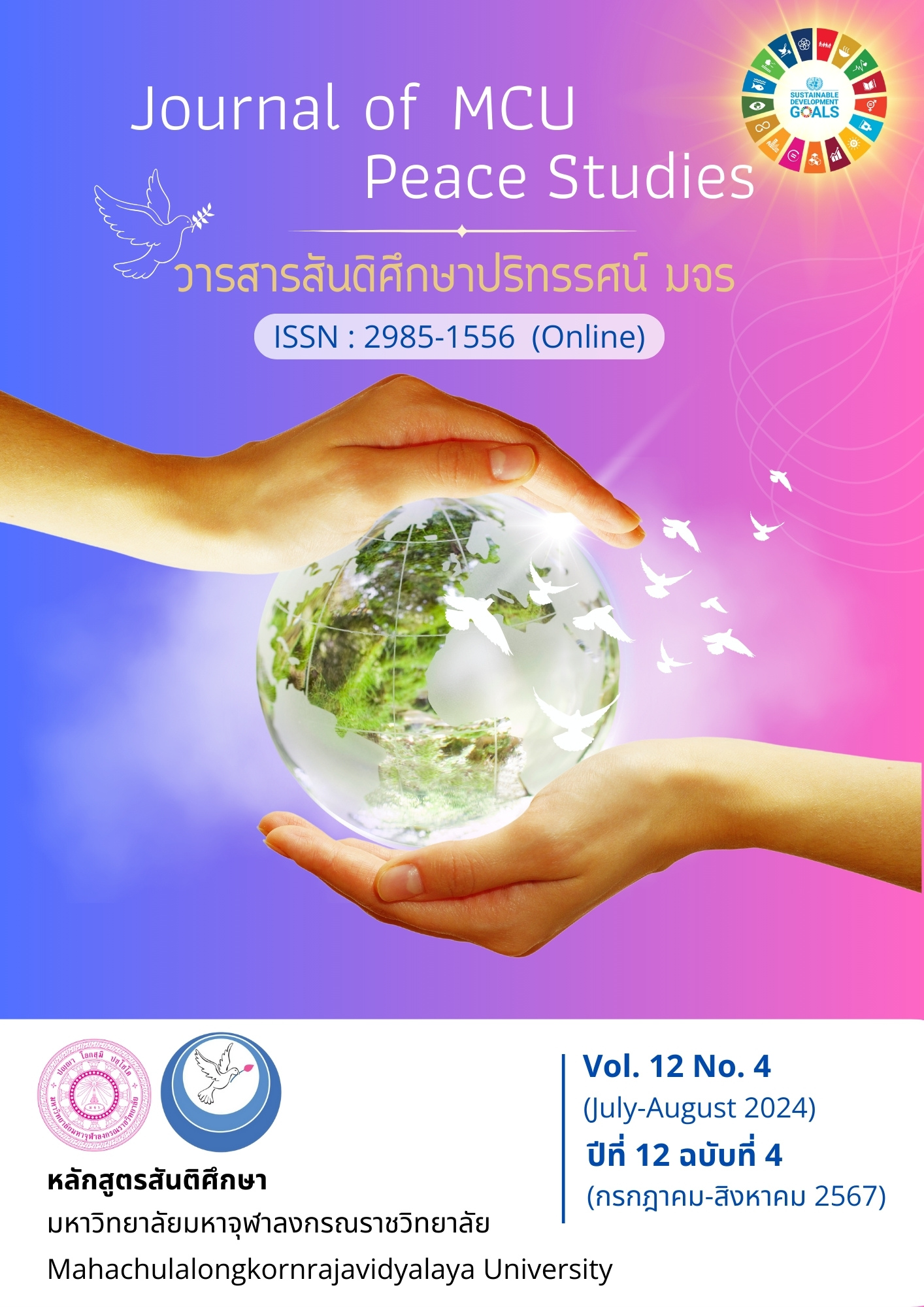โหงวเฮ้ง ศาสตร์การค้นรหัสบุคลิกภาพประเมินพฤติกรรมบุคคลด้วยใบหน้า: การทบทวนวรรณกรรมอย่างเป็นระบบ
Main Article Content
บทคัดย่อ
บทความ เรื่อง โหงวเฮ้งศาสตร์การค้นรหัสบุคลิกภาพประเมินพฤติกรรมบุคคลด้วยใบหน้า: มุ่งเน้นการทบทวนวรรณกรรมอย่างเป็นระบบเพื่อศึกษางานวิจัยที่เกี่ยวข้องกับการศึกษาศาสตร์โหงวเฮ้งในมุมต่าง ๆ รวมถึงศาสตร์ศาสนาและศิลปะในท้องถิ่นและต่างประเทศ เพื่อกำหนดขอบเขตและออกแบบการวิจัยเพื่อเติมเต็มองค์ความรู้ ยกระดับความเข้าใจ และสร้างองค์ความรู้ใหม่โดยใช้การศึกษาจากวรรณกรรมเชิงวิจัยต่าง ๆ เช่น หนังสือ บทความ และเอกสารอื่น ๆ โดยการศึกษาแนวทางเกี่ยวกับศาสตร์โหงวเฮ้ง เพื่อพัฒนาเครื่องมือสันตินวัตกรรม การประเมินพฤติกรรมบุคคลด้วยการใช้รหัสใบหน้าตามแนวทางพุทธสันติวิธีเพื่อสร้างความสัมพันธ์ที่ดีในชุมชนและส่งเสริมสันติสุขในสังคม ผลการศึกษาพบว่ามีการศึกษาศาสตร์โหงวเฮ้ง (Physiognomy) อย่างหลากหลาย แบ่งเป็น 6 ประเด็น ดังนี้ 1) การศึกษาศาสตร์โหงวเฮ้งกับแบบวัดจิตวิทยา 2) การออกแบบและพัฒนาระบบ โหงวเฮ้งอัตโนมัติ 3) การพัฒนาระบบโหงวเฮ้งอัตโนมัติผสมผสานกับแบบวัดทางจิตวิทยา 4) การรับรู้และความเชื่อถือเกี่ยวกับศาสตร์โหงวเฮ้ง 5) ศาสตร์โหงวเฮ้งเพื่อพัฒนาตัวละคร 6) การศึกษาความสัมพันธ์และอิทธิพลระหว่างโหงวเฮ้งเชิงกลยุทธ์กับความเจริญในองค์กร
Article Details

อนุญาตภายใต้เงื่อนไข Creative Commons Attribution-NonCommercial-NoDerivatives 4.0 International License.
ทัศนะและความคิดเห็นที่ปรากฏในบทความในวารสาร ถือเป็นความรับผิดชอบของผู้เขียนบทความนั้น และไม่ถือเป็นทัศนะและความรับผิดชอบของกองบรรณาธิการ ยินยอมว่าบทความเป็นลิขสิทธิ์ของวารสาร
เอกสารอ้างอิง
Chortrakarnkij, P. (2015). Physiologic Augmentation Surgery. Retrieved June 3, 2021, from https://www.si.mahidol.ac.th/sidoctor/e-pl/articledetail.asp?id=1155
Costa, P. T., & McCrae, R. R. (1985). The NEO Personality Inventory Manual. Odessa, FL: Psychological Assessment Resources.
Fathoni, A. C. A. F., Kartika, R., & Lubis, H. S. (2018). Penerapan Physiognomy Untuk Pengembangan Desain Karakter Pada Animasi. Jurnal Dimensi DKV Seni Rupa dan Desain, 3(1), 31-42.
Foo, Y. Z. et al. (2022). Accuracy in Facial Trustworthiness Impressions: Kernel of Truth or Modern Physiognomy? A Meta-Analysis. Personality and Social Psychology Bulletin, 48(11), 1580-1596.
Gloor, A. P. et al. (2022). Your Face Mirrors Your Deepest Beliefs Predicting Personality. Future Internet 2022, 14(5), 1-18.
Hassin, R., & Trope, Y. (2000). Facing Faces: Studies on the Cognitive Aspects of Physiognomy. Journal of Personality and Social Psychology, 78(5), 837-852.
Jia, X., Tian, W., & Fan, Y. (2019). Physiognomy in New Era: A Survey of Automatic Personality Prediction Based on Facial Image. In B. Li et al. (Eds.). ICST Institute for Computer Sciences, Social Informatics and Telecommunications Engineering 2019 (pp. 12-29). Switzerland: Springer Nature Switzerland AG 2019.
Kai, Z. Z. (2021). The Relationship between Personality Traits and Face Shapes in Chinese Traditional Physiognomy. Open Journal of Social Sciences, 9, 81-92.
Kaveetanakul, S., Srikhruedong, S., & Titichoatrattana, W. (2020). Development of Mental Transformation Model Following Buddhist Psychology Classified by Temperament Types. Journal of MCU Humanities Review, 6(1), 71-84.
Ma'arif, A. P., & Wulandari, A. (2021). Face Shape-Based Physiognomy in LinkedIn Profiles with Cascade Classifier and K-Means Clustering. 8th International Conference on Electrical Engineering, Computer Science and Informatics (EECSI), Semarang, Indonesia, 2021 (pp. 347-353). Semarang, Indonesia.
Mohammed, R. K., & Saaed, H. K. (2021). Strategic Physiognomy and its Impact on Organizational Prosperity: An Analytical Research in the State Company for Electrical and Electronic Industries. Journal of Contemporary Issues in Business and Government, 27(3), 2626-2634.
Oommen, A., & Oommen, T. (2003). Physiognomy: A Critical Review. J. Anat. Soc. India, 52(2), 189-191.
Phrakhrupalad Natthaphon Candiko (2018). Characteristic Behavior Modification for Life Development Processes and Practices. Panidhana Journal, 14(1), 55-84.
Phrakhruphisonkitchathon (Thoetthun Dhammakamo). (2019). The 6 Sciences of Mind Reading. Graduate Studies Review Nakhonsawan Buddhist College, 7(2) (Visakha Bucha Edition). 227-238.
Prapaiaxsorn, Th., & Numun, W. (2022). Beliefs Related to Individuals’ Characteristics Revealed by Their Facial Parts Based on Phlu Luang’s Edition of Physiognomy Textbook. Journal of Southern Technology, 15(2), 70-81.
Qin, R., Gao, W., Xu, H., & Hu, Z. (2016). Modern Physiognomy: An Investigation on Predicting Personality Traits and Intelligence from the Human Face. Sci. China Inf. Sci. 61, 058105.
Sudiana, D. Rizkinia, M., & Rafid, I. M. (2021). Automatic Physiognomy System Using Active Appearance Model and Convolutional Neural Network. In Proceedings of the 2021 17th International Conference on Quality in Research (QIR): International Symposium on Electrical and Computer Engineering, Depok, Indonesia, 2021 (pp. 104-109). New York: Institute of Electrical and Electronics Engineers (IEEE).
Tidball, E. B., Prabhala, S., & Gallimore, J. J. (2006). Making Faces: Exploring Perceptions of Personality Based on Emotional Expressions. Proceedings of the Human Factors and Ergonomics Society 50th Annual Meeting 2006 (pp. 885-888). San Fransisco, USA: Human Factors and Ergonomic Society.
Yujie, L., Huang, L. M., Huang, w., & Liang, J. (2017). A Physiognomy-Based Method for Facial Feature Extraction and Recognition. Journal of Visual Languages & Computing, 43(2017), 103-109.


